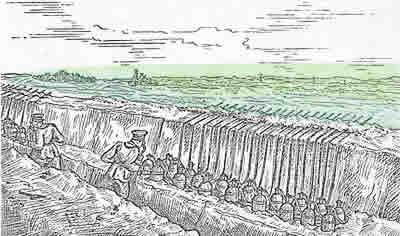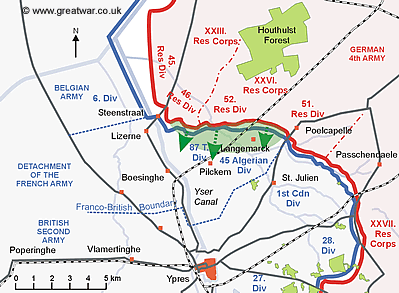 The gas valves are opened
The gas valves are opened
22 April 1915: 17.00
At exactly 5pm [British time - 6pm German time] the valves on the gas bottles were opened. The gas immediately began to flow through the lead pipes laid over the breastworks of the front line fire trench. Within 10 minutes the cylinders were empty. Leutnant Max Tiessen wrote in his history of the 213 Reserve-Infanterie-Regiment:
“It was an indescribable, unforgettable image for those of us witnessing this first gas attack at close range.” (1)
“A hellish, sulphurous haze...”

The following three German soldiers gave their impression of the gas as it hissed out of the cylinders and began to flow away from the German front line, carried by a gentle wind. They were located in the German front line north-west of Langemarck on the west side of the railway line.
Lt. Becker of the III. Battalion, 238 Reserve-Infanterie-Regiment, described the moment of the release of the gas:
“Exactly on time the pioneers opened the valves. They leapt from cylinder to cylinder so that the gas cloud was released evenly. A hissing sound began, as though a hundred pipes were letting off steam. As the cloud rolled forward it was yellowish-green, a hellish, sulphurous haze. As the sun broke from behind a cloud this new and monstrously beautiful image was lit up before us.” (2)

Oberleutnant Mattenklott, of the II. Battalion, 238 Reserve-Infanterie-Regiment, described how the gas cloud created a haze, as though one was looking at the view through blue-green glass:
“At 3.45pm [British time] we “Stood To”. The wind was blowing from the north-east. It turned a little and had a wind strength of 34 metres per second. Then the II. Battalion HQ sent an order that the cylinders would be opened at 5pm [British time] on the dot ... The gas streamed out of the cylinders in the form of a white steam, which draped itself over the landscape like a blue-green veil. We had tied our protective pad over our nose and mouth but we couldn’t smell the gas in the trench. The view of the whole area looked as if one was looking through blue-green glass. The air was clear and we could still see beyond Langemarck.” (3)
Leutnant Richard Drach was the commander of the 4. Company, 238 Reserve-Infanterie-Regiment. His account went as follows:
“Glorious sunny day! At 5pm [British time] the F-Batteries(4) were opened. A poisonous green smoke drifted out of the fire trenches as far as the eye could see. One could see the landscape bathed in the most beautiful sunshine as though through a fine veil. It looked like the scene from a fairy tale.” (5)
Next>> “Un nuage jaune-vert”: A yellow-green cloud engulfs the French
Acknowledgements
(1) Translated from Königlich Preussisches Reserve-Infanterie-Regiment 213, p. 197
(2) Translated from Geschichte des Reserve-Infanterie-Regiments 238, pp. 56-58
(3) Translated from Geschichte des Reserve-Infanterie-Regiments 238, pp. 59-63
(4) F-Batteries was the code name for the batteries of gas cylinders. The F was the first letter of “Flaschen”, the German word for bottles or cylinders.
(5) Translated from Geschichte des Reserve-Infanterie-Regiments 238, p. 58
Sketch by Dr R Hanslian in Königlich Preussisches Reserve-Infanterie-Regiment 213, p. 186. .